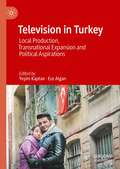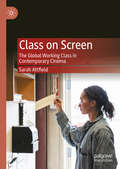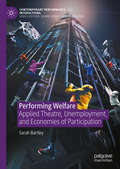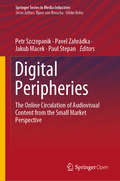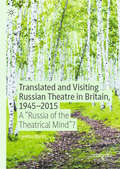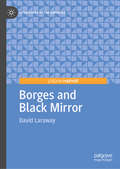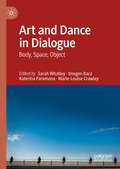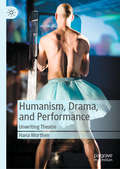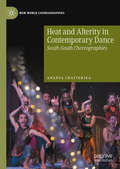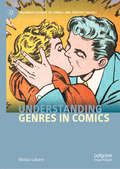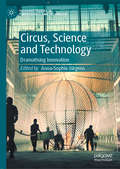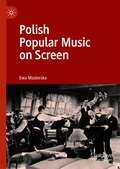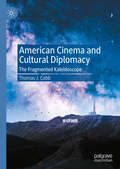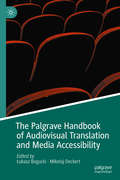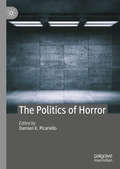- Table View
- List View
Television in Turkey: Local Production, Transnational Expansion and Political Aspirations
by Yeşim Kaptan Ece AlganThis edited collection takes a timely and comprehensive approach to understanding Turkey’s television, which has become a global growth industry in the last decade, by reconsidering its geopolitics within both national and transnational contexts. The Turkish television industry along with audiences and content are contextualised within the socio-cultural and historical developments of global neoliberalism, transnational flows, the rise of authoritarianism, nationalism, and Islamism. Moving away from Anglo-American perspectives, the book analyzes both local and global processes of television production and consumption while taking into consideration the dynamics distinctive to Turkey, such as ethnic and gender identity politics, media policies and regulations, and rising nationalistic sentiments.
Examining The Wire: Authenticity and Curated Realism
by Ryan TwomeyThis book examines The Wire’s authenticity and its establishment of the series realism. Along with tracing creator David Simon’s onscreen critique of numerous failed American institutions, the book focuses on the connection between authenticity and realism in three distinct areas: language, character, and location. While it is shown that The Wire is indeed authentic, the study examines occasions where the language, characters, and even the location are ‘curated’. Yet, while we can witness these moments of curation, it is The Wire’s unflinching focus on authentic dialogue, authentic characterisation, and an authentic location that makes the series the most realistic, and arguably the best, television show of all time.
Class on Screen: The Global Working Class in Contemporary Cinema
by Sarah AttfieldThis book provides an analysis of the global working class on film and considers the ways in which working-class experience is represented in film around the world. The book argues that representation is important because it shapes the way people understand working-class experience and can either reinforce or challenge stereotypical depictions. Film can shape and shift discussions of class, and this book provides an interdisciplinary study of the ways in which working-class experience is portrayed through this medium. It analyses the impact of contemporary films such as Sorry To Bother You, This is England and Le Harve that focus on working class life. Attfield demonstrates that the global working class are characterised by diversity of race, ethnicity, gender, religion and sexuality but that there are commonalities of experience despite geographical distance and cultural difference. The book is structured around themes such as work, culture, diasporas, gender and sexuality, and race.
The Maternal Imagination of Film and Film Theory
by Lauren BlissThis book challenges common sense understandings of the unconscious effects of cinema and visual culture. It explores the castrating power of the early modern witch and the historical belief that pregnant women could manipulate and distort body image as figurative analogies for feminist theories of objectification and the male gaze. Through developing this history as an impure but lively analogy, this book serves as a provocation against the dominant imagining of objectification. It offers innovative analyses of a wide-ranging selection of films and topics including Joyce Wieland’s Water Sark (1964) and its resonance with the works of John Cage and Stan Brakhage; the documentary Histoires d’A (History of Abortion, 1973), which contributed to the successful legalisation of abortion in France; the Hong Kong horror film Dumplings (Jiaozi, 餃子 2004), where foetal cannibalism serves up an image of censorship; and the dual productions The Book of Mary (Le livre de Marie) and Hail Mary (Je vous salue, Marie, 1985) by Anne-Marie Miéville and Jean-Luc Godard that figure a self-reproducing virgin who hears herself while remaining a virgin, unseen.
Explorations in Cinema through Classical Indian Theories: New Interpretations of Meaning, Aesthetics, and Art
by Gopalan MullikThis book explores cinema and film theory through classical Indian theories. While non-Western philosophies have largely been ignored by existing paradigms, Gopalan Mullik responds through an interrogation of how audio-visual images are processed by the audiences at the basic level of their being outside of Western experience. In the process, this book moves away from the heavily Eurocentric film discourse of today while also detailing how this new platform for understanding cinema at the most basic level of its meaning can build upon existing film theories rather than act as a replacement for them.
Post-Crisis European Cinema: White Men in Off-Modern Landscapes
by György KalmárThis book explores the cinematic representations of the pervasive socio-cultural change that the 21st century brought to Europe and the world. Discussing films such as I, Daniel Blake, Cold War and Jupiter’s Moon, it puts distinctively “post-crisis”, gendered representations in a complex, theoretically informed and socially committed interdisciplinary perspective that maps the newly emerging formations of masculinity at a time of rapid socio-economic transition. Kalmar argues that the series of crises that started with the 9/11 terrorist attacks changed some of our fundamental expectations about history, debunked many of our grand narratives, and thus changed the cultural logic of our (thoroughly globalized) civilization. The book focuses on the ways cinema reflects, interprets and shapes a rapidly changing world: the hot issues of the times, the new formations of identity, and the shifts in cinematic representation. This is an interdisciplinary research that is equally interested in what new the 21st century brought about, most specifically to Europe and to its white men, as in film and its responses to these socio-cultural changes.
Performing Welfare: Applied Theatre, Unemployment, and Economies of Participation (Contemporary Performance InterActions)
by Sarah BartleyThis book explores what happens to socially committed performance when state systems of social security are dismantled. Since 2010, a punishing programme of economic austerity and a seismic overhaul of the Welfare State in the United Kingdom has been accompanied by an ideological assault on dependency; a pervasive scapegoating of the poor, young, and disabled; and an intensification of the discursive relationship between morality and work. This book considers the artistic, material, and ideological consequences of such shifts for applied and socially engaged performance. Performing Welfare reveals how such arts practices might reconstitute notions of work and labour in socially constructive ways. It focuses on the political potential of participation during a period in which classifications of labour and productivity are intensely contested. It examines the migration of discourses from state policy to the cultural sector; narratives of community and aesthetics of dependency; the paradoxes of visibility in creative projects with stigmatised participants; the implicit relationship of participatory performance to neoliberal productivity; and, the parallels between gendered divisions of labour, social reproduction, and applied performance. It will appeal to students, scholars, and practitioners interested in applied and socially engaged performance, participation, community, representation, the welfare state, social policy, labour, and unemployment.
Digital Peripheries: The Online Circulation of Audiovisual Content from the Small Market Perspective (Springer Series in Media Industries)
by Petr Szczepanik Pavel Zahrádka Jakub Macek Paul StepanThis is an open access book. Media industry research and EU policymaking are predominantly tailored to large (and, in the latter case, Western) European markets. This open access book addresses the specific qualities of smaller media markets, highlighting their vulnerability to global digital competition and outlining survival strategies for them. New online distribution models and new trends in the consumption of audiovisual content are limited by, and pose new challenges for, existing audiovisual business models and their legal framework in the EU. The European Commission’s Digital Single Market (DSM) strategy, which was intended e.g. to remove obstacles to the cross-border distribution of audiovisual content, has triggered a heated debate on the transformation of the existing ecosystem for European screen industries. While most current discussions focus on the United States, Western Europe, and the multinational giants, this book approaches these industry trends and policy questions from the perspective of relatively small and peripheral (in terms of their population, language, cross-border cultural flows, and financial and/or symbolic capital) media markets.
Interpretation and Film Studies: Movie Made Meanings
by Phillip NovakThis book argues that the sustained interpretation of individual movies has, contrary to conventional wisdom, never been a major preoccupation of film studies—that, indeed, the field is marked by a dearth of effective, engaging, and enlightening critical analyses of single films. The book makes this case by surveying what has been written about four historically important and well-known movies (D. W. Griffith’s Way Down East, Marcel Carné’s Port of Shadows, Mike Nichols’s The Graduate, and Michelangelo Antonioni’s Red Desert), none of which has been the focus of sustained critical attention, and by exhaustively examining the kinds of work published in four influential film journals (Cinema Journal, Screen, Wide Angle, and Movie). The book goes on to argue for the value of the work of interpretation, illustrating this value through extended analyses of Roman Polanski’s Chinatown and Christopher Nolan’s Memento, both of which thematize interpretation. Novak demonstrates the causes and consequences of reading poorly and the importance of reading well.
Females in the Frame: Women, Art, and Crime
by Penelope JacksonThis book explores the untold history of women, art, and crime. It has long been widely accepted that women have not played an active role in the art crime world, or if they have, it has been the part of the victim or peacemaker. Women, Art, and Crime overturns this understanding, as it investigates the female criminals who have destroyed, vandalised, stolen, and forged art, as well as those who have conned clients and committed white-collar crimes in their professional occupations in museums, libraries, and galleries. Whether prompted by a desire for revenge, for money, the instinct to protect a loved one, or simply as an act of quality control, this book delves into the various motivations and circumstances of women art criminals from a wide range of countries, including the UK, the USA, New Zealand, Romania, Germany, and France. Through a consideration of how we have come to perceive art crime and the gendered language associated with its documentation, this pioneering study questions why women have been left out of the discourse to date and how, by looking specifically at women, we can gain a more complete picture of art crime history.
Translated and Visiting Russian Theatre in Britain, 1945–2015: A "Russia of the Theatrical Mind"?
by Cynthia MarshThis book tackles questions about the reception and production of translated and untranslated Russian theatre in post-WW2 Britain: why in British minds is Russia viewed almost as a run-of-the-mill production of a Chekhov play. Is it because Chekhov is so dominant in British theatre culture? What about all those other Russian writers? Many of them are very different from Chekhov. A key question was formulated, thanks to a review by Susannah Clapp of Turgenev’s A Month in the Country: have the British staged a ‘Russia of the theatrical mind’?
Experimental Film and Photochemical Practices (Experimental Film and Artists’ Moving Image)
by Kim KnowlesThis book assesses the contemporary status of photochemical film practice against a backdrop of technological transition and obsolescence. It argues for the continued relevance of material engagement for opening up alternative ways of seeing and sensing the world. Questioning narratives of replacement and notions of fetishism and nostalgia, the book sketches out the contours of a photochemical renaissance driven by collective passion, creative resistance and artistic reinvention. Celluloid processes continue to play a key role in the evolution of experimental film aesthetics and this book takes a personal journey into the work of several key contemporary film artists. It provides fresh insight into the communities and infrastructures that sustain this vibrant field and mobilises a wide range of theoretical perspectives drawn from media archaeology, new materialism, ecocriticism and social ecology.
Borges and Black Mirror (Literatures of the Americas)
by David LarawayBorges and Black Mirror convenes a dialogue between one of the most influential writers of the twentieth century, the philosophical fabulist Jorge Luis Borges, and one of the most important writers and producers of the twenty-first century, Charlie Brooker, whose Black Mirror series has become a milestone in an age of “post-television” programming. The book’s introduction provides a detailed examination of the terms of engagement of Borges and Brooker and each of the chapters explores in a sustained way the resonances and affinities between one particular story by Borges and one particular episode of Black Mirror. The result is a series of essays that locate Brooker’s work with respect to a rich literary and philosophical tradition on the one hand and, on the other, demonstrate the relevance of Borges’s work for anyone who wishes to understand one of our most emblematic cultural artifacts in the age of Netflix.
Art and Dance in Dialogue: Body, Space, Object
by Sarah Whatley Imogen Racz Katerina Paramana Marie-Louise CrawleyThis interdisciplinary book brings together essays that consider how the body enacts social and cultural rituals in relation to objects, spaces, and the everyday, and how these are questioned, explored, and problematised through, and translated into dance, art, and performance. The chapters are written by significant artists and scholars and consider practices from various locations, including Central and Western Europe, Mexico, and the United States. The authors build on dialogues between, for example, philosophy and museum studies, and memory studies and post-humanism, and engage with a wide range of theory from phenomenology to relational aesthetics to New Materialism. Thus this book represents a unique collection that together considers the continuum between everyday and cultural life, and how rituals and memories are inscribed onto our being. It will be of interest to scholars and practitioners, students and teachers, and particularly those who are curious about the intersections between arts disciplines.
Humanism, Drama, and Performance: Unwriting Theatre
by Hana WorthenThis book examines the appropriation of theatre and theatrical performance by ideologies of humanism, in terms that continue to echo across the related disciplines of literary, drama, theatre, and performance history and studies today. From Aristotle onward, theatre has been regulated by three strains of critical poiesis: the literary, segregating theatre and the practices of the spectacular from the humanizing work attributed to the book and to the internality of reading; the dramatic, approving the address of theatrical performance only to the extent that it instrumentalizes literary value; and the theatrical, assimilating performance to the conjunction of literary and liberal values. These values have been used to figure not only the work of theatre, but also the propriety of the audience as a figure for its socializing work, along a privileged dualism from the aestheticized ensemble—harmonizing actor, character, and spectator to the essentialized drama—to the politicized assembly, theatre understood as an agonistic gathering.
The Palgrave Handbook of Theatre and Race
by Tiziana Morosetti Osita OkagbueThe first comprehensive publication on the subject, this book investigates interactions between racial thinking and the stage in the modern and contemporary world, with 25 essays on case studies that will shed light on areas previously neglected by criticism while providing fresh perspectives on already-investigated contexts. Examining performances from Europe, the Americas, the Middle East, Africa, China, Australia, New Zealand, and the South Pacifi c islands, this collection ultimately frames the history of racial narratives on stage in a global context, resetting understandings of race in public discourse.
Heat and Alterity in Contemporary Dance: South-South Choreographies (New World Choreographies)
by Ananya ChatterjeaThis book argues that contemporary dance, imagined to have a global belonging, is vitiated by euro-white constructions of risk and currency that remain at its core. Differently, the book reimagines contemporary dance along a “South-South” axis, as a poly-centric, justice-oriented, aesthetic-temporal category, with intersectional understandings of difference as a central organizing principle. Placing alterity and heat, generated via multiple pathways, at its center, it foregrounds the work of South-South artists, who push against constructions of “tradition” and white-centered aesthetic imperatives, to reinvent their choreographic toolkit and respond to urgent questions of their times. In recasting the grounds for a different “global stage,” the argument widens its scope to indicate how dance-making both indexes current contextual inequities and broader relations of social, economic, political, and cultural power, and inaugurates future dimensions of justice.
Quentin Tarantino and Film Theory: Aesthetics and Dialectics in Late Postmodernity
by Federico PagelloThis book examines a set of theoretical perspectives that critically engage with the notion of postmodernism, investigating whether this concept is still useful to approach contemporary cinema. This question is explored through a discussion of the films written and directed by Quentin Tarantino, largely regarded as the epitome of postmodern cinema and considered here as theoretical contributions in their own right. Each chapter first presents key ideas proposed by a specific theorist and then puts them in conversation with Tarantino’s films. Jacques Rancière’s theory of art is used to reject postmodernism’s claims about the ‘death’ of the aesthetic image in contemporary cinema. Fredric Jameson’s and Slavoj Žižek’s dialectical thinking is mobilized to challenge simplistic, ideological readings of postmodern cinema in general, and Tarantino’s films in particular. Finally, the direct influence of Carol Clover’s psychoanalytical approach to the horror genre on Tarantino’s work is discussed to prove the director’s specific contribution to a theoretical understanding of contemporary film aesthetics.
Neo-Noir as Post-Classical Hollywood Cinema
by Robert ArnettNeo-Noir as Post-Classical Hollywood Cinema suggests the terms “noir” and “neo-noir” have been rendered almost meaningless by overuse. The book seeks to re-establish a purpose for neo-noir films and re-consider the organization of 60 years of neo-noir films. Using the notion of post-classical, the book establishes how neo-noir breaks into many movements, some based on time and others based on thematic similarities. The combined movements then form a mosaic of neo-noir. The time-based movements examine Transitional Noir (1960s-early 1970s), Hollywood Renaissance Noir in the 1970s, Eighties Noir, Nineties Noir, and Digital Noir of the 2000s. The thematic movements explore Nostalgia Noir, Hybrid Noir, and Remake and Homage Noir. Academics as well as film buffs will find this book appealing as it deconstructs popular films and places them within new contexts.
Understanding Genres in Comics (Palgrave Studies in Comics and Graphic Novels)
by Nicolas LabarreThis book offers a theoretical framework and numerous cases studies – from early comic books to contemporary graphic novels – to understand the uses of genres in comics. It begins with the assumption that genre is both frequently used and undertheorized in the medium. Drawing from existing genre theories, particularly in film studies, the book pays close attention to the cultural, commercial, and technological specificities of comics in order to ground its account of the dynamics of genre in the medium. While chronicling historical developments, including the way public discourses shaped the horror genre in comics in the 1950s and the genre-defining function of crossovers, the book also examines contemporary practices, such as the use of hashtags and their relations to genres in self-published online comics.
Circus, Science and Technology: Dramatising Innovation (Palgrave Studies in Performance and Technology)
by Anna-Sophie JürgensThis book explores the circus as a site in and through which science and technology are represented in popular culture. Across eight chapters written by leading scholars – from fields as varied as performance and circus studies, art, media and cultural history, and engineering – the book discusses to what extent the engineering of circus and performing bodies can be understood as a strategy to promote awe, how technological inventions have shaped circus and the cultures it helps constitute, and how much of a mutual shaping this is. What kind of cultural and aesthetic effects does engineering in circus contexts achieve? How do technological inventions and innovations impact on the circus? How does the link between circus and technology manifest in representations and interpretations – imaginaries – of the circus in other media and popular culture? Circus, Science and Technology examines the ways circus can provide a versatile frame for interpreting our relationship with technology.
Polish Popular Music on Screen
by Ewa MazierskaThis book examines the interface between Polish popular music and screen media against the background of Polish history, cinema, and popular culture and situates that interface in a local as well as global context. It looks at Polish musicals, biographical films about musicians, documentary films and, finally, music videos. The author draws attention to the immense popularity of musical comedies in Polish interwar cinema, the enduring appeal of musical genres during the period of state socialism, despite their low status in film criticism, and the re-birth of musicals in the 2010s. Mazierska also discusses the most important stars, directors and authors of songs presented in Polish films, and points to the effect of technological changes on inception and transformation of music-centred genres of screen media, including the effect of YouTube on their growth and preservation. The book is informed by the question of how parochial and universal is Polish popular music and its screen representation.
American Cinema and Cultural Diplomacy: The Fragmented Kaleidoscope
by Thomas J. CobbThis book contends that Hollywood films help illuminate the incongruities of various periods in American diplomacy. From the war film Bataan to the Revisionist Western The Wild Bunch, cinema has long reflected US foreign policy’s divisiveness both directly and allegorically. Beginning with the 1990s presidential drama The American President and concluding with Joker’s allegorical treatment of the Trump era, this book posits that the paradigms for political reflection are shifting in American film, from explicit subtexts surrounding US statecraft to covert representations of diplomatic disarray. It further argues that the International Relations theorist Walter Mead’s concept of a US polity dominated by contesting beliefs, or a ‘kaleidoscope’, permeates these changing paradigms. This synergy reveals a cultural milieu where foreign policy fissures are increasingly encoded by cinematic representation. The interdisciplinarity of this focus renders this book pertinent reading for scholars and students of American Studies, Film Studies and International Relations, along with those generally interested in Hollywood filmmakers and foreign policy.
The Palgrave Handbook of Audiovisual Translation and Media Accessibility (Palgrave Studies in Translating and Interpreting)
by Łukasz Bogucki Mikołaj DeckertThis handbook is a comprehensive and up-to-date resource covering the booming field of Audiovisual Translation (AVT) and Media Accessibility (MA). Bringing together an international team of renowned scholars in the field of translation studies, the handbook surveys the state of the discipline, consolidates existing knowledge, explores avenues for future research and development, and also examines methodological and ethical concerns. This handbook will be a valuable resource for advanced undergraduate and postgraduate students, early-stage researchers but also experienced scholars working in translation studies, communication studies, media studies, linguistics, cultural studies and foreign language education.
The Politics of Horror
by Damien K. PicarielloThe Politics of Horror features contributions from scholars in a variety of fields—political science, English, communication studies, and others—that explore the connections between horror and politics. How might resources drawn from the study of politics inform our readings of, and conversations about, horror? In what ways might horror provide a useful lens through which to consider enduring questions in politics and political thought? And what insights might be drawn from horror as we consider contemporary political issues? In turning to horror, the contributors to this volume offer fresh provocations to inform a broad range of discussions of politics.
